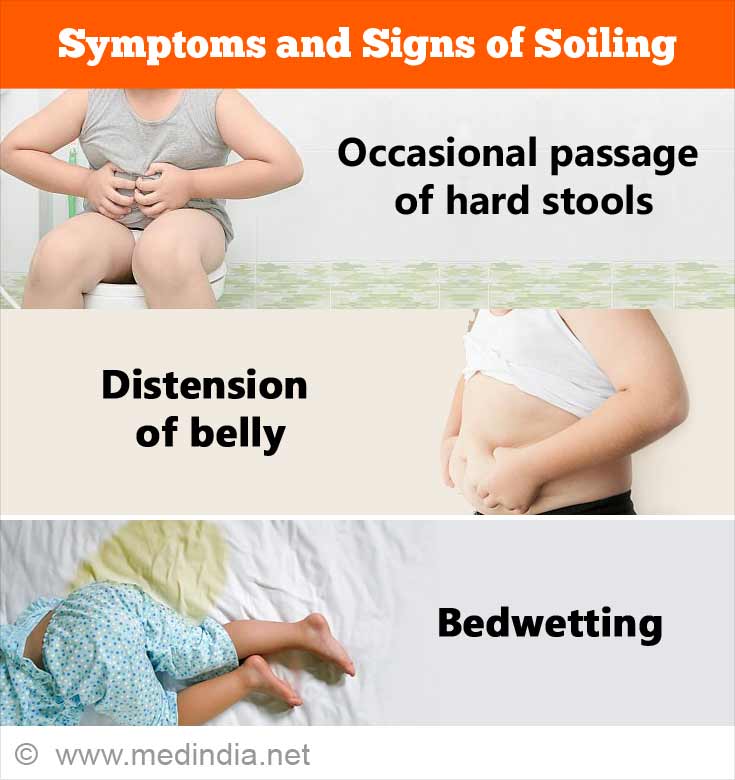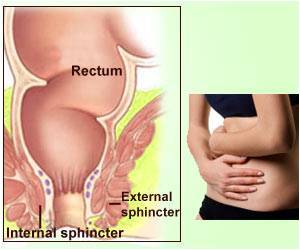- Encopresis - (https://www.cincinnatichildrens.org/health/e/encopresis)
What is Encopresis?
Encopresis also referred to as paradoxical diarrhea or fecal soiling refers to the mostly involuntary leakage of stool leading to soiling of clothes. It is usually seen in children who have been toilet trained (above 4 years) but can occur in adults also. The causative factors in children and adults may vary.
In children the most common cause is constipation which typically happens before encopresis. Due to constipation, the accumulated feces becomes hard and remains in the rectum. When the rectum becomes distended and full, liquid stool leaks around the hard impacted feces and stains the clothes.
What are the Causes of Encopresis?
The causes of encopresis in children and adults vary
| Children | Adults |
|
|
What are the Symptoms and Signs of Encopresis?
- Chronic constipation and occasional passage of hard stools
- Avoiding bowel movements
- Soiling of clothes due to leakage of stools despite constipation
- Using a lot of toilet paper than normal to clean up
- Distension of belly
- Poor appetite
- Passing foul smelling gas
- Pain and discomfort in belly
- Pain while passing stools
- Secretive behavior in children associated with bowel movements
- Recurrent urinary infections especially in girls
- History of bedwetting (enuresis)
- Low self-esteem in the child due to embarrassment and fear of being teased

What are the Risk Factors of Encopresis?
- Recurrent episodes of constipation
- Poor toilet training
- Changing toilet training routine
- Male gender
- Stressful situation eg. divorce, death of parent or grandparent, shifting home
- Travel and uncomfortable feel of using unfamiliar toilets
- Sexual abuse
- Underlying disease – diabetes, hypothyroidism
- Anal fissure
How do you Diagnose Encopresis?
Parents may seek medical advice due to problems with child’s bowel habits and episodes of fecal soiling.
History and physical examination
The doctor will obtain a detailed history including occurrence of constipation, diet history, details of toilet training and conduct a thorough physical examination to identify cause of constipation and rule out other causes of fecal soiling
Digital rectal examination
The doctor gently introduces a lubricated, gloved finger into the anal opening while gently pressing the lower part of the belly with the other hand and checks for presence of hard impacted fecal mass
Imaging
- Abdominal x-ray to check the amount of stool in the large intestine and demonstrate hard fecal mass
- Contrast enema, a test that gives a clearer picture of the bowel to check for blockage of intestine, any abnormal narrowing or other conditions that may be causing constipation
Psychological evaluation
If the doctor suspects emotional disturbances as the possible cause of fecal soiling, he may recommend a psychological evaluation
Encopresis with Constipation and without Constipation – Quick Comparison
| Parameters to compare | Encopresis with Constipation | Without Constipation |
| Frequency of bowel movements | Seldom | Normal |
| Stool quantity | Large amounts | Normal |
| Pain during stool passage | Can be present | No |
| Abdominal pain | Yes | No |
| Appetite | Reduced | Normal |
| Palpable lump in abdomen | Often felt | No |
| Stool transit time | Prolonged | Normal |
| Mass in rectum | Often felt | No |
| Rectal diameter on ultrasound | Increased | Normal |
| Laxative therapy | Useful | Not useful, can worsen |
| Bedwetting | More common (upto 1/3rd ) | Less common |
How do you Treat Encopresis?
Treating Encopresis in a Child
The earlier treatment begins for encopresis, the better for the child. It is important during evaluation to distinguish whether encopresis in a child is due to constipation or occurs in the absence of constipation because each requires a different treatment.
In encopresis with constipation, laxatives combined with toilet training is the method of treatment. In the absence of constipation, the main form of treatment is toilet training
- Clearing the colon of retained, impacted stool
- Toilet Training
- Lifestyle changes to ensure regular bowel movement
- Psychotherapy

Clearing the Colon
The colon must first be cleared of the impacted feces. This can be done by using
- Laxatives – These are orally administered agents that act by stimulating bowel movement, reducing transit time of digested food in the bowel and softening the stool eg castor oil, senna, milk of magnesia, magnesium sulphate, psyllium
- Enema – A tube is introduced into the rectum to infuse fluid that will stimulate evacuation of bowel. Usually enemas contain a mixture of soap and water or glycerine and water and are used to relieve constipation
Toilet Training
Children should be made to sit on the toilet three times a day, after meals. This is particularly useful since the bowel movement is stimulated when food enters the stomach.
Lifestyle Changes to Avoid Constipation
- Encourage the child to take plenty of fluids
- Consume fiber rich diet - apples, strawberries, dark green leafy vegetables, beans, broccoli
- Consume dairy products as per doctor’s advice
- Training the child to empty bowels as soon as the urge to pass stools is felt
- Placing a foot stool in the toilet can help the child to change the position of the legs to put more pressure on the belly and ease bowel movement
- Laxatives if needed and discontinuing once a regular bowel pattern sets in
- Encouraging activity and play by limiting TV time or smartphone use
Psychotherapy
- Counseling to retrain bowel and cause behavior modification
- Biofeedback
- Be gentle with the child and do not criticize for soiling clothes
- Praise the child for following prescribed diet, going to the toilet and be supportive
- Sometimes when encopresis happens in the absence of constipation psychologic evaluation may be considered to find a possible cause
Encopresis in Adults
A more careful assessment has to be done as there are many underlying conditions that can cause chronic constipation. Finding the cause and treating it is important.
However, initial treatment must include clearing the bowel by prescribing laxatives or giving an enema.
Other measures once the bowel is cleared include lifestyle changes similar to mentioned above and periodic use of stool softeners and fiber supplements to ease bowel movement.











